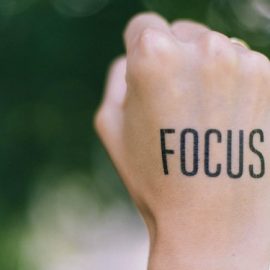

This article is an excerpt from the Shortform book guide to "Not Nice" by Aziz Gazipura. Shortform has the world's best summaries and analyses of books you should be reading.
Like this article? Sign up for a free trial here.
Do you put other people first? What are ways to prioritize yourself?
A crucial part of unlearning niceness is prioritizing yourself. This helps you stop being a people pleaser, and finally put yourself first before anyone else.
Continue reading to learn how to prioritize yourself.
Prioritize Yourself
You’re responsible for your needs. No one else will meet them. To learn how to prioritize yourself, practice asking yourself what you want and need and how to get it. If you have a long history of being nice, you might think this sounds selfish, but selfishness is a matter of perspective. According to Not Nice by Aziz Gazipura, it exists on a spectrum, from self-sacrificing (too nice) to thoughtlessly selfish (only caring about oneself). He advocates the middle ground: healthy self-interest.
(Shortform note: The idea of healthy self-interest has implications beyond personal development. Economist Adam Smith, author of The Wealth of Nations, also advocated self-interest, stressing the importance of fulfilling individual needs within societal contexts. Smith’s economic framework shows that responsible self-interest, when balanced with social responsibility, can lead to overall societal prosperity, akin to Gazipura’s ideas about personal growth and well-being.)
Gazipura says that the problem is that after being nice for so long, you may no longer be a good judge of what selfish looks like. If you’re not sure, think through the cost-benefit analysis of your decision—how much you want something versus how much it will impact the people around you. If you don’t want something that much, or if the impact on someone else is too high, reconsider or brainstorm how to meet your needs another way. But if you really want something and other people are minimally impacted, go for it.
(Shortform note: The idea of cost-benefit analysis has its origins in the utilitarian philosophy that emerged in the 18th and 19th centuries. Pioneered by philosophers Jeremy Bentham and John Stuart Mill, utilitarianism asserts that the best actions are those that maximize overall happiness and minimize overall suffering. This essentially means assessing the collective good derived from an action against its potential drawbacks or costs. When applied in everyday decisions, as suggested by Gazipura, it involves gauging how much you value a particular outcome against the potential repercussions it might have on others. In essence, it’s a balance between individual desires and the broader implications of those choices.)
Start by Saying No
A part of prioritizing yourself is learning to say no. Saying no will improve every aspect of your life. Saying no to nonessential tasks at work keeps you focused on the things that matter most, and saying no in your personal life allows you to do the things you want instead of wasting time on the things you don’t.
(Shortform note: If you’re used to saying yes, it can be hard to know when you should say no. The Pareto Principle, or the 80/20 rule, provides guidance, proposing that 80% of your results come from only 20% of your efforts. Evaluating your activities and commitments with this principle in mind helps discern which actions truly yield substantial outcomes versus those that monopolize your time with little reward. By zeroing in on the crucial 20% and saying no or delegating the rest, you can channel your energy into the most fruitful aspects of your life—for example, prioritizing friendships that enhance your wellbeing over those that don’t.)
So why is it so scary to say no? According to Gazipura, this fear stems from patterns of insecure attachment that manifest as insecurity in relationships. We aren’t afraid of saying no, but we’re afraid that saying no will make someone reject or abandon us. But saying no doesn’t damage the relationship, being inauthentic does. Authenticity allows for genuine connections because it ensures that both parties are expressing their true selves and respecting each other’s boundaries.
| How to Say No Knowing you should say no doesn’t necessarily make it easier. In Essentialism, Greg McKeown outlines specific strategies to say no more effectively. 1. Be gracious. You can express gratitude for the offer, even if you decline. For example, “Thank you for thinking of me, but I won’t be able to commit to that at this time.” 2. Pause before committing. Instead of immediately agreeing to requests, take a moment to reflect. This pause allows you to assess whether the opportunity aligns with your priorities and capacity. You can use phrases like, “Let me check my schedule” or “I need some time to think about it” to give yourself time to evaluate. 3. Respond with a “No, but…” Rather than a flat rejection, consider offering alternatives or compromises. This approach can help maintain relationships while still guarding your time and energy. For instance: “I can’t take on this project, but I can provide some guidance to the person who does.”These strategies are aimed at helping you decline requests or opportunities in a respectful and assertive manner while also keeping your own priorities in mind. |

———End of Preview———
Like what you just read? Read the rest of the world's best book summary and analysis of Aziz Gazipura's "Not Nice" at Shortform.
Here's what you'll find in our full Not Nice summary:
- Why there's a cultural fixation on niceness
- How individuals and society would benefit from being less nice
- How to break free from the people-pleasing trap and empower yourself






